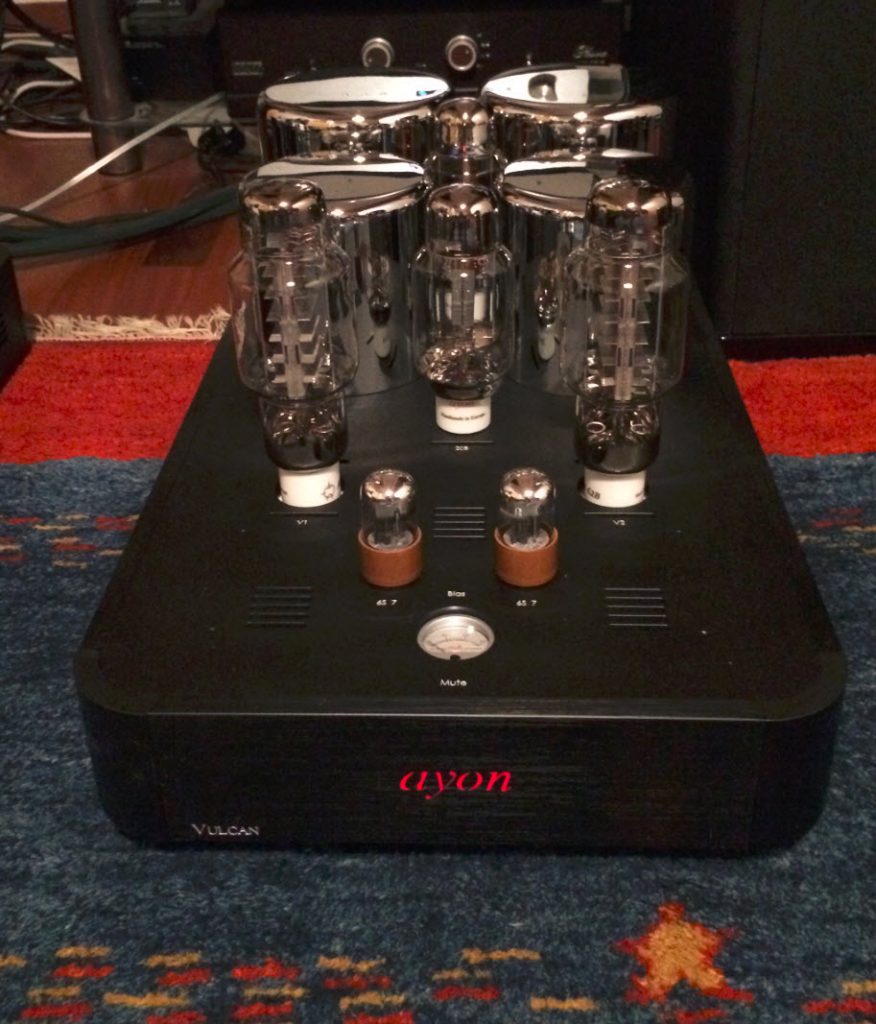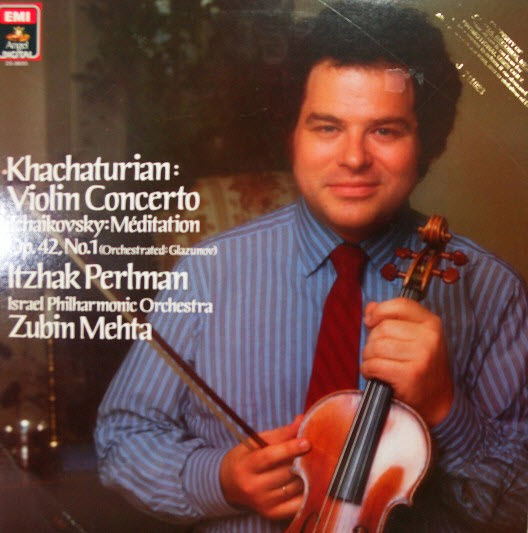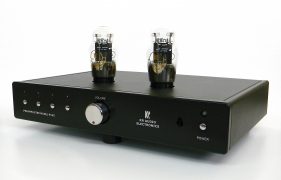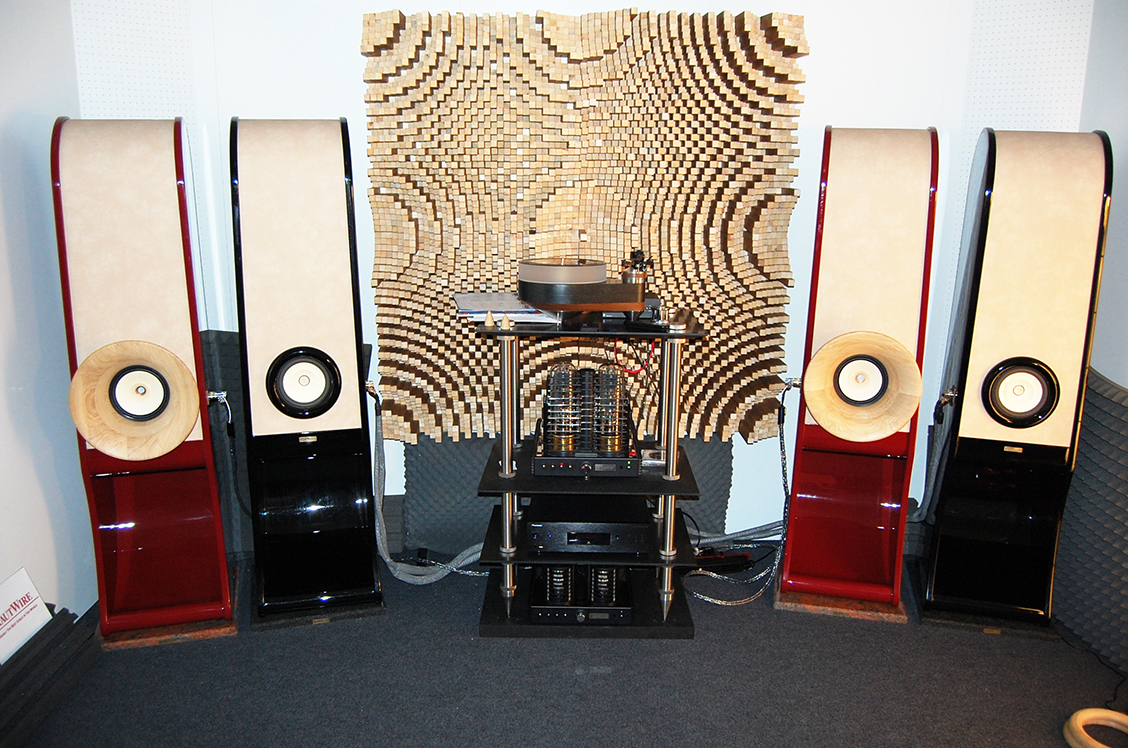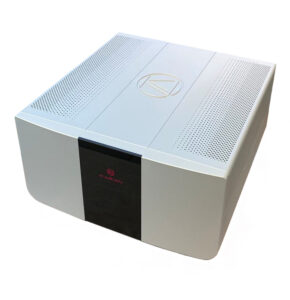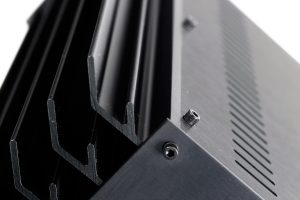Ayon Audio has over the last 15 years become one of the best known high end tube amplifier manufacturers, at least here in Europe. In particular, they have become known as one of the premier manufacturers of single ended amplifiers (SETs), preamplifers and digital sources and got their start in taking the designs from the defunct Vaic amplifier company out of the Czech republic. Once the company changed its name to Ayon, under Gerhard Hirt's direction, the company moved its base of operations to Austria.
I first encountered Ayon when it was still called Vaic but by then under the management Gerhard Hirt and the company had moved to Austria. The amplifiers were designed by Vaic using the new tube designs such as the 520B (later the 52B) and constructed by the Italian amplifier manufacturer (also a SET designer) Mastersound. A few years later I got reacquainted with the brand, whose name had then been changed to Ayon but the amplifiers were still built by Mastersound but had migrated to the newer 52B-S, which has been well documented in past reviews to be a "super" 300B designed by Ayon itself. That encounter, at the Munich High End Show, was when I realized that Ayon was a serious contender for making the best SET amps in the world. A pair of Ayon 52B Reference monoblocks and an Ayon preamplifier (maybe the Polaris I?) were driving a pair of Lumen White speakers. The soundstage at the show demo was just huge with holographic images dancing within a truly holographic 3d soundstage. Those big monoblocks also delivered the delicacy and midrange glory that SET is famous for but with a big tight bass wallop and crystal clear extended highs for which SETs were not known for at all.
Over the years I had kept track of Ayon's progress, new models, new tube designs and evolution of their industrial design. I had been impressed year after year by the sound I heard at the Munich show and by the consistency of the company's growth and clear vision of what Ayon stood for guided by Gerhard. Now, to be sure, they expanded their product lineup to include push/pull amplifiers and a wide range of digital products but their premium lineup has always been their SET amps based on the 52B, 62B, and now 82B "300B derivatives" and their advanced preamplifiers.
I finally had the opportunity to get an Ayon amplifier for myself in early 2016, the Crossfire III, as a demo model from a local dealer. This replaced a pair of very good sounding Wall Audio Opus M50 monoblocks that I had been using. The replacement was more of a shift in perspective than a wholesale, across the board improvement. The Crossfire III was more neutral with higher apparent resolution, more powerful bass and more extended highs. Detail increased by a small but significant level over the Walls. Where the Walls were equal to the Crossfire was in overall macro dynamics and palpability of images and soundstaging. Still, the Crossfire III is true top class SET sound but without much extra warmth, which might be pleasant, but is a bit cloying over time as it appears with nearly all recordings. Also, the Crossfire III dug deeper into the recording with superior inner resolution and microdynamics than the Walls, which seem to give more the surface of a sound and not as much of its inner structure.
So, having a good taste finally of what the latest Ayon brings to the party in their second from the bottom of the line in their 62B range, I contacted Ayon to see if I could formally review one of their new Evo version amplifiers, which I had still never heard outside of shows. Gerhard responded positively and asked if I would like to review the new Vulcan Evo monoblocks. I naturally agreed, as my wish was being granted, and a few weeks later I went to the local Swiss dealer and brought home (with the help of a friend) two large boxes containing the large Vulcan Evo monos.
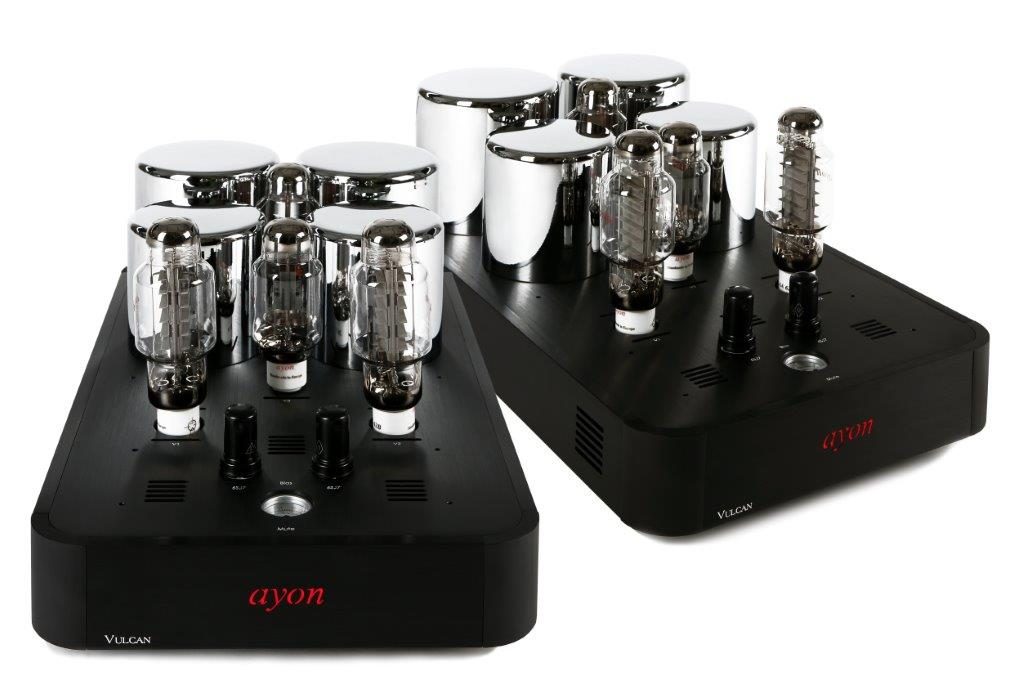
The Vulcan Evo is a direct line descendant from the Vaic/Ayon 52B Reference monos, it is a parallel SET using either the 62B or the new 82B DHT triodes that are made by Ayon in their Czech factory. What makes the Evo even more like its ancestor than the previous generation Vulcan (the Mk II) is the return to using a DHT as a driver tube. The old Reference used the 8B and the new Vulcan Evo uses a newly designed tube from Ayon the AA20B, both of which are DHTs unlike previous generation Vulcan II that used an EL84 wired as a triode as the driver tube.
One major difference between the previous Vulcans and the Evo is the change as well in the input tubes. Previously, the unusual but very good sounding 6SJ7 pentode (wired in triode) was used but the new Evo is using 6SN7s. As my Crossfire three is using 2 6SJ7s per channel on the input to feed the 6N30 driver tube, I was curious about the change in concept. Gerhard explained to me that the new AA20B is a more difficult drive and requires more current than the 6SJ7 can deliver comfortably. Gerhard further said that although the 6SJ7 might work it is these small percentage differences that gives the Vulcan Evo its special sound and that it is not just the use of the AA20B but how the circuit preceding it is behaving that has to be just right to give the resulting sound quality. Interestingly, the old 52B Reference was also using a 6SN7 as an input tube to drive the 8B driver tube. Finally, he told me that before when a 6N30 was used as a driver the 6SJ7 was perfect because the 6N30 is not as demanding and the sound character of the tube went well with the 6N30… this is how my Crossfire III is configured.
Both the old Reference and the Vulcan line use a 5U4G tube rectifier for the input and driver circuits but in the new Evo we again get a very special rectifier, the Ayon 5U4G mesh plate, which is actually nearly as large as the 62B output tubes! I compared this to the Svetlana NOS winged "C" 5U4G that I use in my Crossfire and the size difference between the two is stunning as is the sound difference. Naturally, there are many other differences between the latest Vulcan Evo and its ancestor in terms of power supply design and passive parts choice but the basic formula is similar and from my past experience a very potent one.
One obvious change in the design of the new Ayon from the Ayon of say 10-15 years ago is the external styling. Once decked out in chrome and wood side cheeks, the modern Vulcan, and Ayon in general, is sleek, black, stealthy and rather a serious business look. True, the look is nicely contrasted with the shiny chromed transformer covers and bright red "Ayon" logo on the front, but the Vulcans look more "Imperial Star Destroyer" than "Starship Entereprise". One of the main reasons Gerhard gives for the design is that the structural integrity of this aluminum plate design is much higher than the earlier chassis and this has led to positive sonic benefits. That being said, I find the look of the Vulcans impressive and they are bound to catch the attention of anyone walking into a room that sees them.
The packaging, while not wooden crates that are often the standard for amps of this price and weight, are very stout box-within-a-box double thick cardboard with massive custom foam inserts. Each of the chromed transformer is covered by a velvet bag that fits over each can to protect the delicate mirror like finish. Removing the amps from the box one is stuck by the industrial looking black massive aluminum chassis and gleaming chrome towers… it reminds this sci-fi buff of a pair of Imperial Star Destroyers… and certainly all business.
Sound
The initial impression I got when firing up the Vulcan Evos and sitting down for my first serious listening session (after an appropriate 2 hour warm up) was not so much about explosive dynamics or anything that its name implies but refinement. To be sure, the dynamic contrasts were superb and the transparency world class but there was a delicacy inner resolution that was among the very best I have heard. My Crossfire III has just as much inner resolution as the Vulcan Evos; however, it came out sounding slightly coarse in comparison. The Vulcan sounded a bit like a smoothing filter had been applied but that filter did nothing to reduce the resolution and transparency of what I was hearing. This first impression of refinement or even slightly silkiness persisted throughout the entire review period and is one of the outstanding traits of the amplifier. Interestingly, the Wall Audio Opus M50s have a similar silkiness to the midrange but are also somewhat more colored overall and significantly lower in overall resolution.
One potential reason for this resolution with refinement comes from how the Vulcan Evo presents the high frequencies. They are undoubtedly slightly soft and yet present, although not with the same energy as the rest of the frequency range. Nothing is missing but compared to the Crossfire and even the Wall Audio amplifiers, there is a delicacy to the highs from the Vulcan that helps to give this refinement sensation. One of my audio visitors commented that him the highs were rolled off with the Vulcan and that it did not have the "air" of some other top-end amps (for reference, he is coming from Spectral SS gear) but that the soundstage depth and width and refinement were compelling nonetheless. I never personally felt the highs to be rolled off per se as I could still hear all the detail that was present with other, more obviously treble rich, amps. However, I could see how this softness could be interpreted this way.
Transparency, and in particular resolution of the soundstage and low level information, was again near the best I have heard. Back of the hall sounds were clearly resolved and importantly, the space around instruments that are set back in the stage or extraneous noises (like Keith Jarrett's moans on "The Koln Concert") also had air and space around them that was only hinted at by the Crossfire and was mostly absent from the Wall Audio Opus M50s. Now, at first glance, there was not obviously higher transparency or resolution, which I think is in part due to the overall tonal balance of the Vulcan Evo. This I will go into more detail below. However, in direct comparison with both digital and analog, it was clear that the Vulcan dug deeper into the earth for those subtle sounds and delivered them in such an elegant manner. Subtle sounds like the difference in pressure a pianist applies to keys of different notes as he plays (i.e. mechanical action of the piano not just the string vibration), for example, were rendered more audibly and therefore more realistically than most other amplifiers I have heard. This dynamic gradation on such a micro scale was quite impressive and added to the satisfaction I got in listening to the Vulcans.
This transparency and low level resolution allowed for a deep and wide soundstage with precisely placed images of good tactile density at different distances and well separated from each other within that soundstage. The Crossfire also dose this well with only a slight foreshortening of the soundstage. The Walls are also very competent at producing solid 3D images but their placement within the soundstage is less secure and front to back layering is less delineated; however, the Walls did arguably put out the most palpable of images between the three amps. The difference was that a lot of the subtlety and air around images along with the inner resolution the Ayon amplifiers are both very good at was not as well developed with the Walls.
At times and with certain recordings, like Jan Garbarek's "Dis", the wind harp was nearly delivering a wraparound effect that was totally immersive. The Crossfire tends to keep things slightly more at a distance from and emotional perspective. Perhaps this is due to the tonal balance differences between the two amplifiers? Not sure, but the emotional factor for the Vulcan is quite high. However, I suspect that it has a lot to do with the change in input tube and especially the 20B driver tube. That extra stage of DHT seems to bring more fluidity and less harshness compared to small signal indirectly heated tubes.
The tonal center of the Vulcans is set a bit lower than the Crossfire. There is not really more heft in the lower bass, both amps are among the very best in terms of bass weight and control for SET amplifiers, but more of a thrust in the mid/upper bass that gives a slightly fuller body sound than the Crossfire. The Walls are balanced a bit in between the two amplifiers. The other noticeable difference was again the slightly soft top end. For sure the highs are present and you never feel like you miss them but they are noticeably softer and less "present" than either comparison amplifier. It could be argued that the Crossfire's highs are slightly prominent but I would not say so since they are so clean and articulated. The Walls, again fall somewhere in between but are less well differentiated but perhaps more tonally rich than the Crossfires.
This difference was very clearly heard on Pat Metheny "Watercolors" where there is some nice stick work with the drums that this well recorded and the Vulcans do soften this slightly whereas both the Walls and Crossfire show it more prominently; however, everything is put into space more convincingly with the Vulcans. Other well recorded cymbal percussion, like on the ECM record "Solstice" or horn blats from Die Valkyrie (Decca 1965, Georg Solti) were somewhat brighter and crisper with the Crossfire and yet less tonally complex and therefore less real compared to the Vulcans.
There is real power and dynamic thrust with the Vulcans when listening to orchestral music like the Britten Piano concerto (on Decca) or Katchachurian Violin concerto (played by Itzahk Perlman and conducted by Zubin Mehta on EMI) when the low strings are playing aggressively. Resolution of instruments within the orchestra are also well resolved… as well as the recording allows. The macro dynamic contrasts are extremely well handled and the amplifiers were seemingly unflappable on my 97dB/watt horns (of course I was probably only using a couple of watts max on peaks or less). I was not able to try out the Vulcans on less sensitive speakers but I have no doubt that it will drive speakers down to 90dB/watt (even less in smaller rooms) without issue because I have tried this with my Crossfire, which rated at about half the power, and it too was able to easily drive lower sensitivity conventional speakers with ease.
Playing with fire?
Summing up the sound of the Vulcan Evos I would say that they are refined and subtle with great perceived transparency and resolution, both in terms of individual instruments and sounds as well as how they carve out resolution in the soundstage and capable of delivering huge macrodynamic contrasts. There seems to be no blunting or rounding of dynamics throughout a large envelope, at least with my speakers. Inner resolution and the sense of action in sound was among the very best I have heard.
Tonally, the sound balance is perhaps slightly lower midrange centered with great differentiation in the bass and a powerful foundation. The highs are slightly soft and delicate in comparison to the Crossfire III and Wall Audio Opus M50s but all the information was there and this slight softness was perhaps contributed positively to soundstage presentation. It also meant that three dimensionality was very good it was not as pushed forward or quite as palpable as what the Walls delivered.
I truly enjoyed my time with the Vulcan Evos as I frequently lost myself in music for hours at a time with no fatigue and always a great sense of discovery. These are truly great amplifiers and if you have the kind of money it takes to buy this level of amplifier then I recommend a serious audition. It will deliver dynamic and refined musical performance that makes a lot of other very good amps sound coarse and less realistic. Enthusiastically recommended!
Ayon Audio Vulcan Evo Amplifiers
Retail: $41,400 (US)
Ayon




